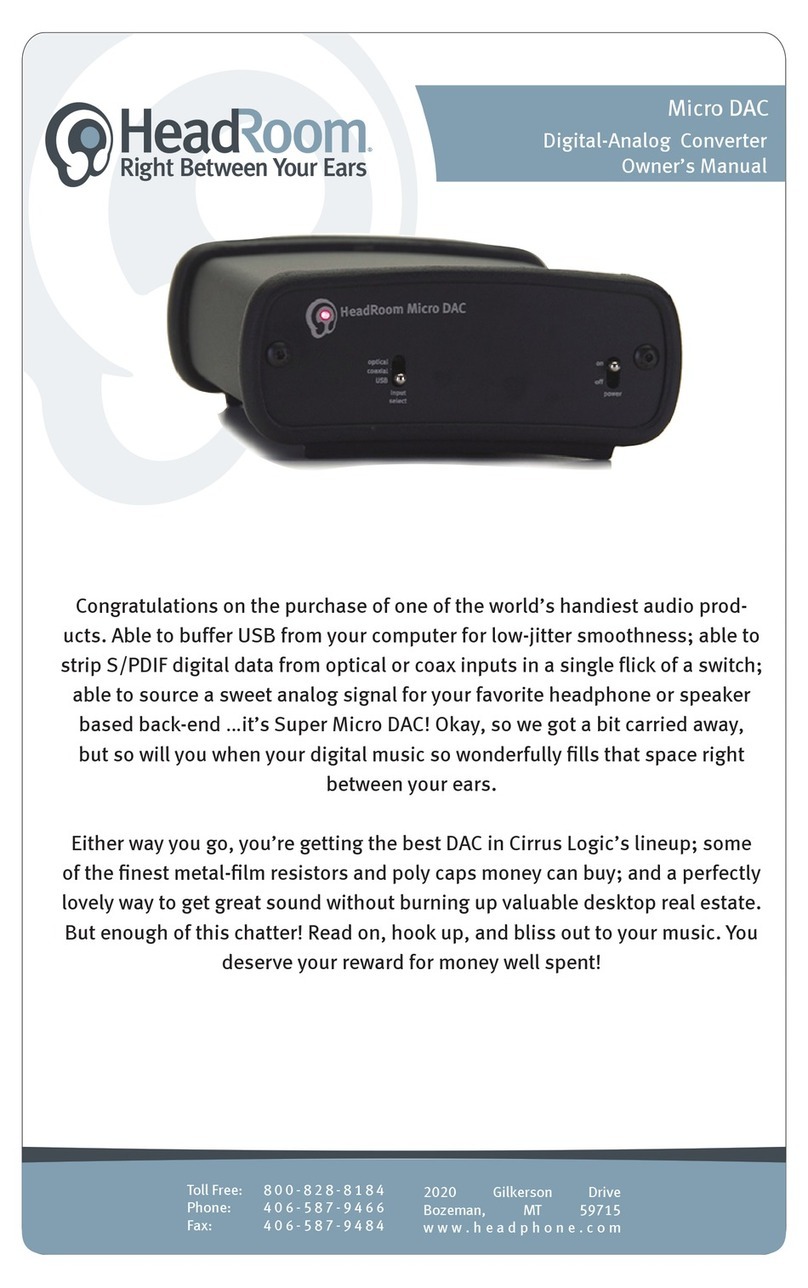
Imagine you are listening to a pair of speakers. If you turn off the left speaker,
both ears hear the sound from the right speaker. But because the left ear is
slight farther away than the right ear, it hears the speaker’s sound slightly
after the right ear; about 300 microSeconds. This time difference is called the
“inter-aural time difference” and it is the main thing your brain listens for in
order to tell where to place sound left-to-right.
But in headphones if you turn off the left channel, only the right ear hears the
sound. In headphones, if there is any sound that is only in the left channel, or
only in the right channel, then only that ear hears the sound. This is not natu-
ral, and you brain becomes fatigued trying to fi gure out where sound is com-
ing from when only one ear is hearing it. This tends to create an audio image
that is a blob on the left, blob on the right and a blob in the middle.
HeadRoom amplifi ers cure the problem by allowing you to cross-feed a little
of the left and right channels across to each other through a short time de-
lay using the crossfeed switch. The usefulness of the circuit varies depending
on what type of recording you are listening to; mono and binaural recordings
need no processor at all. Old studio recordings that have instruments panned
hard left or right, benefi t greatly from the processor. Live and classical record-
ings miked from a distance benefi t somewhat less, and can often be listened
to without the processor quite comfortably.
Plain
Headphones
With
HeadRoom
The crossfeed switch in
HeadRoom amplifi ers al-
low you to cross-feed a
little of the left and right
channels across to eacho-
ther through a short time
delay.
Far ear
hears
slight delay.
Near ear
hears sound
fi rst.
What is the HeadRoom Crossfeed?
Micro DAC & Ultra Micro DAC Common Features
• Multiple Digital Inputs
• DC coupled signal path, from input to output
• Full dual mono design all the way back to the power supply
• Discrete emitter follower ouput stage, biased into class A operation (the Dia-
• Resistors are low noise, low drift .1% metal fi lm types
• Local device decoupling with low-ESR, tight tolerance PPS fi lm capacitors
• Power supply decoupling with ultra low ESR electrolytics
• Shortest signal path possible, PCB routed with high-speed signal integrity
• Multi-layer PCB with dedicated, low impedance power and ground layers
What’s the difference betwen the Micro DAC & Ultra Micro DAC?
The difference between a Micro DAC and Ultra Micro DAC is that the Ultra Mi-
cro DAC uses TI 627 in its output stage and has an Analog Devices AD1896
Asynchronous Sample Rate converter to upsample and the incoming data to
24-bit, 196kHz; smooth the upsampled data with an interpolation fi lter; and
then reclock the data into the DAC with an ultra-low jitter clock oscillator. The
result is smoother data lending toward a pleasing liquid sound more similar
Micro Ultra DAC
Features & Differences
upsampling
circuitry
current
regulator
diodes























